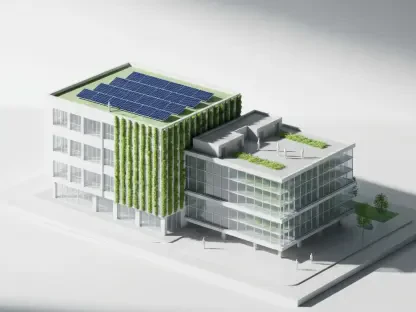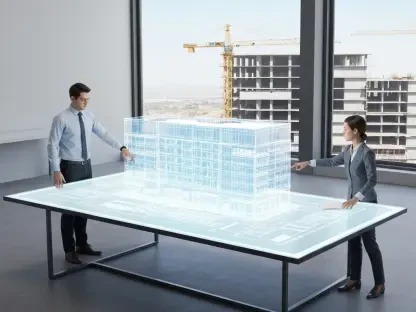The architectural walls sector is undergoing noteworthy growth and transformation, emerging as a vital area within construction and interior design. This market focuses on a myriad of wall systems, such as modular, movable, and fixed walls, implemented in various settings, including commercial, residential, and institutional environments. Frequently known as demountable partitions, glass walls, or operable walls, these structures are crafted to deliver flexibility, aesthetic allure, and functional advantages, making them an enticing option for modern architectural designs. As the market evolves, the demand for architectural walls continues to escalate, driven by changing lifestyles and sustainable building needs.
The market’s expansion is significantly influenced by the increasing pursuit of sustainable building solutions, adaptable office environments, and innovative interior designs, catering to shifting work and lifestyle requirements. From residential units to office spaces, architectural walls are transforming how spaces are utilized, presenting opportunities for enhanced functionality and aesthetic appeal. With the market valued at a substantial USD 193.24 billion in 2023 and with projections to USD 207.06 billion by 2024, it anticipates reaching USD 359.6 billion by 2032, implying a robust CAGR of approximately 7.15% from 2025 onwards.
Versatility and Application of Architectural Walls
Architectural walls provide key advantages in space management flexibility, facilitating easy reconfiguration in various settings, such as offices, healthcare facilities, educational institutions, and hospitality sectors. The adoption of modular systems in commercial locations continues to rise due to their ability to adapt easily to evolving demands, whether creating open-plan offices or private meeting spaces. These walls enable businesses to adjust layouts with minimal disruption, a crucial feature for many contemporary workplaces where agility is paramount. By supporting dynamic work environments, architectural walls contribute to enhanced operational efficiency and employee satisfaction.
Demountable walls are designed as modular systems that can be installed, removed, and reconfigured with limited interference. Constructed with materials such as glass, wood, or metal, they offer versatility and an appealing visual presence. Glass walls especially advance natural light penetration, fostering an open atmosphere while maintaining acoustic separation. Yet, operable walls—movable partitions that fold or slide—boost adaptability in spaces like conference centers and hotels. Fixed partitions, serving as permanent structures, merge robustness with aesthetic refinements, often using sustainable materials. These varied wall types demonstrate different strengths tailored to diverse environments and client preferences.
Market Propellants and Challenges
Several factors drive the upward trajectory of architectural walls. There is a notable demand for flexible workspaces, necessitated by hybrid work models that call for adaptable office surroundings. This demand propels companies toward architectural walls that enable easy, efficient reconfiguration for collaboration, privacy, or hybrid setups without costly renovations. Sustainability also plays an integral role; architectural walls frequently use recyclable materials, aligning them with green building certifications like LEED. This alignment attracts environmentally conscious developers and businesses focused on reducing their ecological footprint through intelligent design.
However, the market faces challenges, including high costs for premium wall systems. These expenses can restrict adoption, especially among smaller organizations or budget-strained projects. In cases where glass walls are utilized, certain systems might inadequately meet acoustic demands, hindering them from serving noise-sensitive areas like recording studios. Regulatory compliance further complicates matters, with varying building codes and fire safety regulations across regions posing barriers for manufacturers and installers. Despite these hurdles, the sector remains optimistic, with efforts to address these challenges through innovation and design improvements.
Regional Insights and Market Trends
The architectural walls market displays varied regional dynamics. In North America, particularly the U.S., the market enjoys robust construction industry support and a demand for contemporary office designs. Companies like Haworth and Steelcase contribute significant expertise, fortifying the market’s presence. In Europe, countries such as Germany, the UK, and France are at the forefront of adopting sustainable and innovative wall systems, guided by strict environmental policies and a commitment to green building practices. The Asia-Pacific region, featuring rapid urbanization in China, India, and Japan, demonstrates growing interest in architectural walls, particularly for commercial and residential projects.
Meanwhile, the Middle East and Africa show promising interest, with regions like the UAE and Saudi Arabia investing in luxury commercial and hospitality projects supported by extensive urban development plans. Emerging trends shape the future landscape, including smart walls incorporating IoT technologies, optimizing lighting, temperature control, or acoustic management. Sustainable materials—recycled and bio-based—are increasingly sought to meet evolving environmental standards. Moreover, acoustic improvements counteract traditional material limitations, and prefabrication coupled with modular construction accelerates building processes, reducing onsite labor and costs.
Future Considerations
The architectural walls sector is experiencing notable growth and change, becoming an essential part of construction and interior design. This market encompasses various wall systems, such as modular, movable, and fixed walls, designed for settings including commercial, residential, and institutional spaces. Often referred to as demountable partitions, glass walls, or operable walls, these structures offer flexibility, visual appeal, and practical benefits, making them attractive choices for contemporary architectural designs. As the market evolves, there is an increasing demand for these walls, spurred by evolving lifestyles and the need for sustainable buildings.
The expansion is driven by a growing focus on sustainable constructions, flexible office solutions, and innovative interior designs that meet changing work and lifestyle needs. Architectural walls are redefining space utilization in homes and offices, offering improved functionality and aesthetics. With the market valued at USD 193.24 billion in 2023 and projected to grow to USD 207.06 billion by 2024, it is expected to reach USD 359.6 billion by 2032, reflecting a strong CAGR of about 7.15% starting from 2025.









